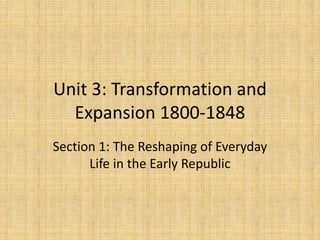
Unit 3 transformation and expansion
- 1. Unit 3: Transformation and Expansion 1800-1848 Section 1: The Reshaping of Everyday Life in the Early Republic
- 2. Essential Questions • How did innovations in industry, technology and transportation affect Americans’ lives? • What explains the difference in Northern and Southern social and economic development and how did it affect political unity?
- 7. Unifying of a Nation • Advances in communications and transportation enabled Americans to expand westward. • These advances also united the country and allowed information and products to be transported greater distance in shorter periods of time.
- 8. Section 2 SLAVERY AND THE CONSTRUCTION OF RACE IN AMERICA
- 9. Essential Questions • Why did the idea of race and the practice of racism develop along with African slavery in America? • Could the South have thrived without slavery?
- 12. Section 3 MANIFEST DESTINY AND ITS CONSEQUENCES
- 13. Essential Questions • What were the costs and benefits of westward expansion? Why did so many Americans move west? • How should we understand the West and the frontier? Was it a place of democracy, equality, and adventure, or rather a place of oppression and conquest? • Did the “pioneer spirit” stop once the nation spanned the continent?
- 14. Reasons for Westward Expansion A. Economic factors 1) Exhaustion of good soil by cotton farmers led to search for new land 2) Effects of the Panic of 1837. Many settlers pushed west as they faced economic losses. B. Psychological factors--manifest destiny. Sentiment that the U.S. should rule from coast to coast (and maybe pole to pole) became a key part of national thinking. C. Attractive regions for new settlement--east Texas, California, Oregon D. Advertising the West 1) Santa Fe traders brought back tales of the West 2) Mountain men--fur trappers and traders
- 15. Our Manifest Destiny [is] to overspread the continent allotted by Providence for the free development of our yearly multiplying millions John L. O’Sullivan 1845
- 16. Manifestations of Destiny Emanuel Gottlieb Leutze: Westward John Gast: American Progress the Course of Empire Takes Its Way (1872) (1861)
- 17. Section 4 NATIVE AMERICANS’ STRUGGLE TO SURVIVE
- 18. Essential Questions • Why did some Native Americans fight against white society while others tried to assimilate? Which was the right choice? • Can the federal government ever make amends for its treatment of Native Americans?
- 19. Cultural Assimilation of Native Americans 1. Assimilation involved the following: • Settling the land and farming • Adopting Christianity • Learning English and European cultural norms • Abandoning traditional tribal cultures 2. Assimilations efforts included: • Indian Removal Act 1830: Allowed the U.S. government to forcibly relocate natives to reservation lands in the west • Dawes Act of 1887: Allotted plots of land to individual natives in exchange for abandoning tribal control.
